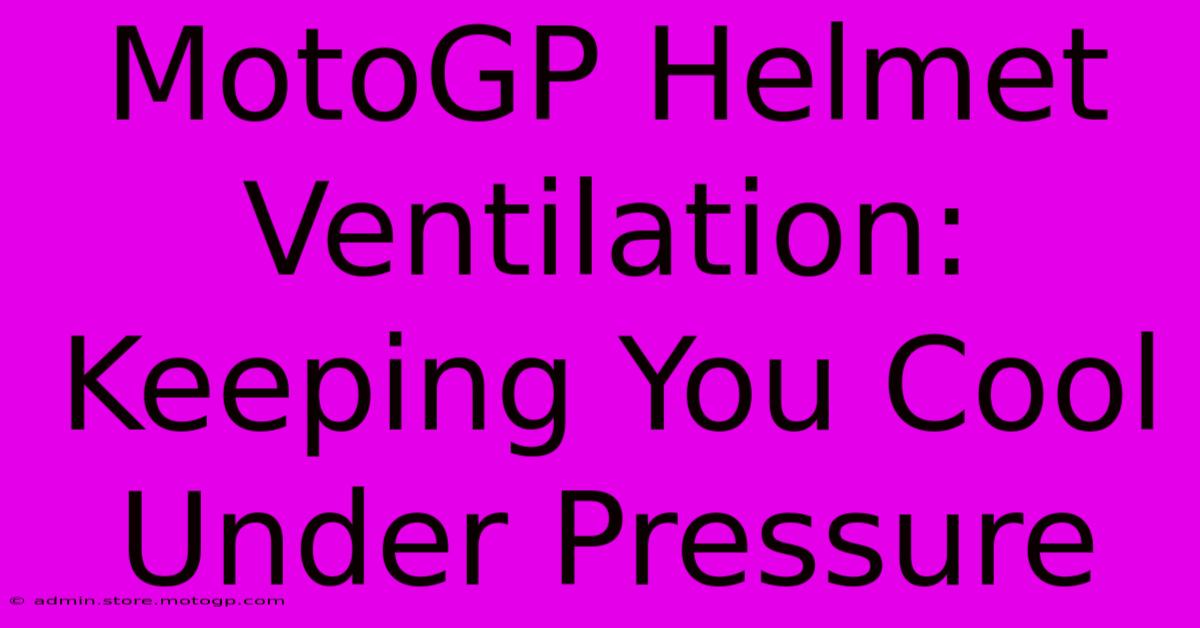MotoGP Helmet Ventilation: Keeping You Cool Under Pressure

Table of Contents
MotoGP Helmet Ventilation: Keeping You Cool Under Pressure
MotoGP racing pushes riders to the absolute limit, demanding not only peak physical performance but also unwavering mental focus. A crucial, often overlooked, factor contributing to a rider's success is their helmet's ventilation system. The intense heat and exertion experienced during a race can lead to dehydration, overheating, and impaired cognitive function – all of which can significantly impact performance and safety. Effective helmet ventilation is therefore paramount, and this article delves into the critical role it plays.
The Importance of Helmet Ventilation in MotoGP
The extreme conditions of MotoGP demand exceptional helmet ventilation. Riders experience high speeds, intense acceleration, and deceleration, generating significant heat. The combination of physical exertion, ambient temperature, and the enclosed nature of a racing helmet creates a potentially dangerous environment. Poor ventilation can lead to:
- Overheating: Excessive heat can cause fatigue, dizziness, and impaired judgment, significantly increasing the risk of crashes.
- Dehydration: Sweating increases significantly during races, and inadequate ventilation can hinder evaporative cooling, leading to rapid dehydration.
- Reduced Cognitive Function: Heat stress impacts cognitive function, affecting reaction times and decision-making abilities – vital aspects of safe and competitive racing.
- Discomfort and Reduced Focus: Simply feeling uncomfortable and excessively hot distracts a rider from the race, hindering their performance.
How MotoGP Helmet Ventilation Works
Modern MotoGP helmets employ sophisticated ventilation systems designed to maximize airflow and minimize heat buildup. These systems typically include:
Multiple Air Intakes:
Strategically positioned intakes on the chin bar, forehead, and crown draw cool air into the helmet. These intakes are often adjustable, allowing riders to customize airflow based on conditions.
Internal Air Channels:
A network of internal channels directs the incoming air across the rider's head and face, promoting effective cooling. These channels are meticulously designed to optimize airflow and minimize turbulence.
Exhaust Vents:
Exhaust vents at the rear of the helmet expel hot, humid air, creating a continuous flow of cool air throughout the helmet.
Advanced Materials:
Lightweight, high-performance materials are crucial for both ventilation and overall helmet performance. These materials contribute to the helmet's structural integrity while allowing for efficient airflow.
Choosing the Right MotoGP Helmet Ventilation System
Selecting a helmet with optimal ventilation requires considering several factors:
- Number and placement of vents: More vents generally mean better airflow, but their placement is equally critical.
- Internal channel design: The efficiency of the internal channels significantly impacts cooling performance.
- Material of the helmet shell: The shell's porosity influences airflow.
- Helmet liner: Moisture-wicking liners help to manage sweat and enhance cooling.
- Rider-specific needs: A rider's physiology and riding style can influence their ventilation requirements.
The Future of MotoGP Helmet Ventilation
Ongoing research and development continuously improve MotoGP helmet ventilation. Innovations include:
- Computational Fluid Dynamics (CFD): CFD simulations help optimize air intake and exhaust designs.
- Active ventilation systems: Systems with electronically controlled fans could further enhance cooling.
- Smart helmet technology: Integrating sensors to monitor temperature and adjust ventilation automatically.
Conclusion:
In the high-stakes world of MotoGP, even the smallest details can make a significant difference. Effective helmet ventilation is not merely a comfort feature; it's a crucial element contributing to rider safety, performance, and overall success. The constant evolution of helmet technology ensures that riders are equipped to withstand the extreme physical and environmental demands of MotoGP racing. The focus on maximizing airflow and minimizing heat build-up remains a key area of ongoing innovation, ultimately contributing to a safer and more competitive racing environment.

Thank you for visiting our website wich cover about MotoGP Helmet Ventilation: Keeping You Cool Under Pressure. We hope the information provided has been useful to you. Feel free to contact us if you have any questions or need further assistance. See you next time and dont miss to bookmark.
Featured Posts
-
General Admission Cota Easy Access Maximum Fun
Feb 19, 2025
-
Direct To The Action F1 Shuttle Transportation
Feb 19, 2025
-
Cota Your Source For Family Fun
Feb 19, 2025
-
Moto Gp Bike Costs A Deep Dive
Feb 19, 2025
-
Discover The Latest Cota Merchandise
Feb 19, 2025
